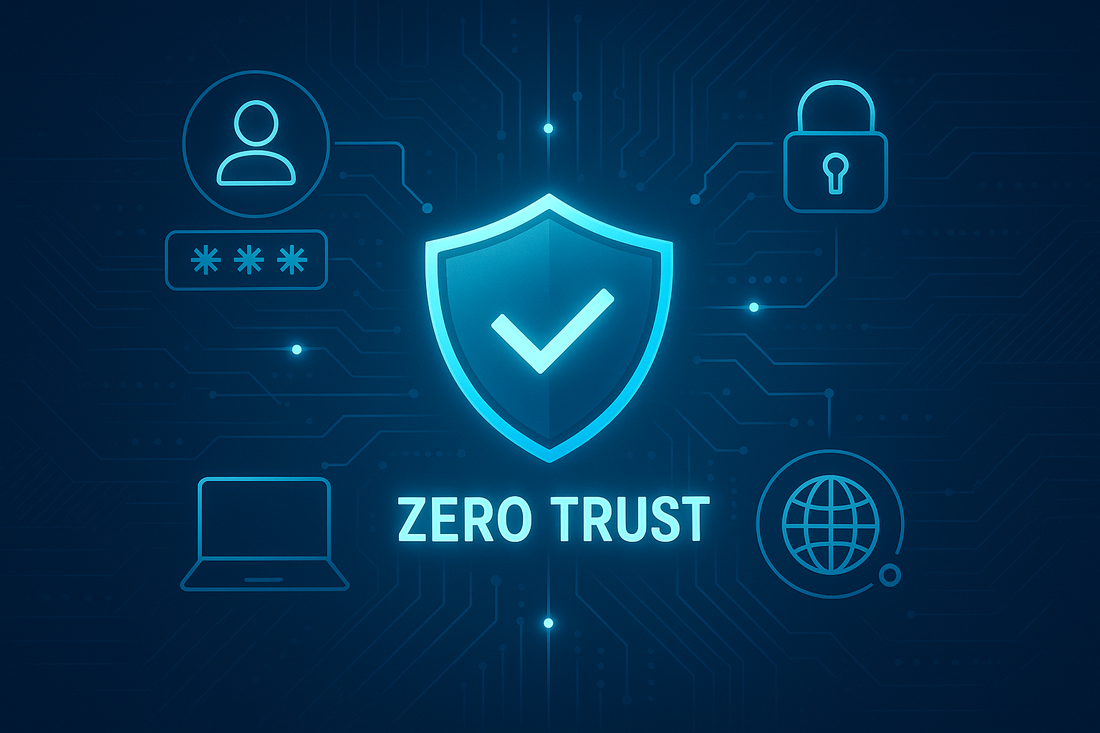
Improve Your Security with Zero Trust
Jessica MooreShare
In our rapidly evolving digital landscape, cybersecurity threats have become increasingly sophisticated and persistent. Traditional perimeter-based security models that relied on firewalls and network boundaries are no longer sufficient to protect modern organizations.
The Zero Trust security model has emerged as a revolutionary approach to cybersecurity, fundamentally changing how we think about network security and access control.
For organizations implementing SSL Certificates and secure communications, understanding Zero Trust principles is crucial for building a robust security infrastructure that can withstand contemporary threats.
Zero Trust represents a paradigm shift from the traditional "castle and moat" security model to a more granular, verification-based approach. This security framework operates on the principle that no user, device, or network should be trusted by default, regardless of their location within or outside the network perimeter. Every access request must be verified, authenticated, and authorized before granting access to resources, making SSL Certificates a critical component of this security architecture.
The Core Principles of Zero Trust Architecture
The Zero Trust security model is built upon several fundamental principles that work together to create a comprehensive security framework.
The first and most important principle is "never trust, always verify".
This means that every user, device, application, and data flow must be authenticated and authorized before being granted access to any resources. Unlike traditional security models that assume internal network traffic is trustworthy, Zero Trust treats all network traffic as potentially hostile.
The second core principle involves implementing the principle of least privilege access. This approach ensures that users and devices are granted only the minimum level of access necessary to perform their specific functions.
By limiting access rights, organizations can significantly reduce their attack surface and minimize the potential impact of security breaches. SSL Certificates play a vital role in this principle by providing encrypted channels for secure communication and authentication.
Continuous monitoring and validation form the third pillar of Zero Trust architecture. The security posture of users, devices, and applications must be continuously assessed and monitored throughout their entire session, not just at the initial point of access. This ongoing verification process helps detect anomalous behavior and potential security threats in real-time, allowing for immediate response and mitigation.
How Zero Trust Security Models Function in Practice
The implementation of Zero Trust security involves multiple layers of verification and control mechanisms working in concert.
When a user attempts to access a resource, the Zero Trust system first verifies their identity through multi-factor authentication processes. This initial verification is followed by device authentication, where the system confirms that the accessing device meets security requirements and has not been compromised.
Network segmentation plays a crucial role in Zero Trust implementations, creating micro-perimeters around individual resources or groups of resources. Each segment is protected by its own security controls, and movement between segments requires additional authentication and authorization. SSL Certificates are essential for securing communications between these segments, ensuring that data remains encrypted and authenticated as it traverses the network infrastructure.
Context-aware access control is another critical component of Zero Trust functionality. The system evaluates multiple contextual factors, including user location, device health, time of access, and behavioral patterns, to make dynamic access decisions. These contextual elements help the system identify potentially suspicious activities and adjust security controls accordingly. Trustico® SSL Certificates provide the cryptographic foundation that enables secure context evaluation and policy enforcement.
The Critical Role of SSL Certificates in Zero Trust Security
SSL Certificates serve as fundamental building blocks in Zero Trust architectures by providing essential encryption and authentication capabilities.
In a Zero Trust environment, every communication channel must be secured and verified, making SSL Certificates indispensable for protecting data in transit. SSL Certificates establish secure, encrypted connections between clients and servers, ensuring that sensitive information cannot be intercepted or tampered with during transmission.
Trustico® SSL Certificates offer comprehensive solutions for Zero Trust implementations, providing both Trustico® branded and Sectigo® branded SSL Certificates to meet diverse organizational needs. Our SSL Certificate portfolio includes Domain Validation (DV), Organization Validation (OV), and Extended Validation (EV) options, each designed to provide different levels of authentication and trust assurance within Zero Trust frameworks.
The mutual authentication capabilities provided by SSL Certificates are particularly valuable in Zero Trust environments. Client SSL Certificates can be used to authenticate devices and users, ensuring that only authorized entities can access protected resources. This bidirectional authentication strengthens the overall security posture by verifying both the server and client identities before establishing secure communications.
Implementing Zero Trust with Trustico® SSL Certificate Solutions
Organizations implementing Zero Trust architectures require robust SSL Certificate management capabilities to support their security objectives. Trustico® SSL Certificates provide the scalability and flexibility needed to secure complex, distributed environments where traditional perimeter-based security models are insufficient.
The automation capabilities offered by Trustico® CaaS SSL Certificate solutions are particularly beneficial for Zero Trust environments, where the dynamic nature of access controls requires rapid SSL Certificate provisioning and renewal. Automated SSL Certificate lifecycle management ensures that SSL Certificates remain valid and properly configured, preventing security gaps that could be exploited by malicious actors. This automation is essential for maintaining the continuous verification requirements of Zero Trust architectures.
Trustico® SSL Certificates support various deployment scenarios common in Zero Trust implementations, including cloud-native applications, microservices architectures, and hybrid environments. Our SSL Certificate solutions provide the flexibility to secure communications between different components of distributed systems while maintaining the strict authentication and encryption requirements of Zero Trust security models.
Benefits of Zero Trust Security for Modern Organizations
The adoption of Zero Trust security models provides numerous advantages for organizations seeking to improve their cybersecurity posture. One of the primary benefits is the significant reduction in attack surface area. By eliminating implicit trust and requiring verification for every access request, Zero Trust makes it much more difficult for attackers to move laterally through networks once they gain initial access. This containment capability helps prevent small security incidents from escalating into major data breaches.
Zero Trust architectures also provide enhanced visibility into network activities and user behaviors. The continuous monitoring and logging requirements of Zero Trust generate detailed audit trails that help security teams identify potential threats and investigate security incidents more effectively. This improved visibility extends to SSL Certificate usage and management, allowing organizations to maintain better control over their cryptographic infrastructure.
The flexibility and scalability of Zero Trust models make them particularly well-suited for modern business environments characterized by remote work, cloud adoption, and digital transformation initiatives. Unlike traditional perimeter-based security models that struggle to accommodate distributed workforces and cloud resources, Zero Trust adapts seamlessly to changing business requirements while maintaining consistent security policies and controls.
Overcoming Zero Trust Implementation Challenges
While Zero Trust offers significant security benefits, organizations often face challenges during implementation. One common challenge is the complexity of redesigning existing network architectures to support Zero Trust principles.
Legacy systems and applications may not be compatible with Zero Trust requirements, necessitating careful planning and phased migration strategies. Trustico® SSL Certificates can help bridge these compatibility gaps by providing standards-based encryption and authentication that works with both modern and legacy systems.
Another implementation challenge involves managing the increased complexity of identity and access management systems. Zero Trust requires sophisticated identity verification and access control mechanisms that can be overwhelming for organizations with limited security expertise.
Performance considerations also play a role in Zero Trust implementations, as the additional verification steps and encryption requirements can impact system performance. However, modern SSL Certificate implementations, including those offered by Trustico® are optimized for high-performance environments and can support the demanding requirements of Zero Trust architectures without significant performance degradation.
Future Trends and Evolution of Zero Trust Security
The Zero Trust security model continues to evolve as new technologies and threat vectors emerge. Artificial intelligence and machine learning are increasingly being integrated into Zero Trust systems to improve threat detection and response capabilities. These technologies enable more sophisticated behavioral analysis and anomaly detection, helping organizations identify potential security threats more quickly and accurately.
The integration of Zero Trust principles with emerging technologies such as Internet of Things (IoT) devices and edge computing presents both opportunities and challenges.
SSL Certificates will play an increasingly important role in securing these distributed environments, providing the authentication and encryption capabilities necessary to maintain Zero Trust principles across diverse device ecosystems.
Cloud-native Zero Trust implementations are becoming more prevalent as organizations migrate their infrastructure and applications to cloud platforms. Trustico® SSL Certificates are well-positioned to support these cloud-native deployments, offering the scalability and automation capabilities needed to secure dynamic, containerized environments while maintaining Zero Trust security requirements.
Strengthening Your Security Posture with Zero Trust and Trustico® SSL Certificates
Zero Trust security represents a fundamental shift in how organizations approach cybersecurity, moving from perimeter-based models to comprehensive, verification-based frameworks. The implementation of Zero Trust principles requires robust cryptographic infrastructure, making SSL Certificates essential components of any Zero Trust architecture. Trustico® SSL Certificates provide the security, scalability, and management capabilities necessary to support successful Zero Trust implementations across diverse organizational environments.
By combining Zero Trust security principles with Trustico® SSL Certificate solutions, organizations can significantly improve their security posture while maintaining the flexibility and performance required for modern business operations.
As cybersecurity threats continue to evolve and become more sophisticated, the adoption of Zero Trust security models will become increasingly critical for organizational survival and success. Trustico® SSL Certificates provide the trusted foundation upon which secure, resilient Zero Trust architectures can be built, helping organizations protect their most valuable assets while enabling secure digital transformation initiatives.



